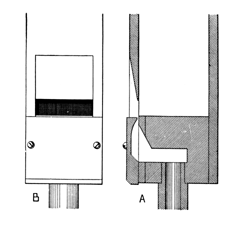
|
Clarabella English Claribel English |
Claribella English? Offenflöte German |
|
Flauto Tedesca Italian? |
Dolciano (unknown) |

The Clarabella, whose name derives from the Latin clarus (“bright”) and bellus (“beautiful”), is an open wooden flute invented by J. C. Bishop in the early 1800's; Grove dates it from around 1825, Sumner from around 1840. It was originally a Stopped Diapason with the stoppers removed, intended to replace the treble range of that stop, which Bishop found insufficient to balance the ever-increasing power of the Open Diapasons of the time. Pitched at 8', it was at first a treble stop only, starting at middle C, and later extending down to tenor C, the bass being of stopped pipes or borrowed from another rank. The open pipes of the Clarabella were only rarely extended down to 8' C. While Bonavia-Hunt maintains there is no advantage to using open pipes in the bass octave, claiming that the break between open and stopped pipes “can be completely covered by a skilful voicer & finisher”, other sources insist that the preferred practice is to use open pipes throughout. It became a great favorite of English organ builders, appearing more often than not in instruments of the latter half of the 1800's. By the turn of the century, Wedgwood reported that it had apparently fallen into disfavor. It is almost invariably found at 8' pitch, and rarely at 16' or 4'.
The tone of the Clarabella has been variously described as fluty, full, round, velvety, thick, dull, and cloying. It has been compared to the Hohlflöte, though not as strong and full. Audsley considers its tone to be midway between that of the Hohlflöte and the Open Diapason. Maclean suggests that it may be considered a scaled-down Pedal Open Wood, and Bonavia-Hunt writes: “The 16' Clarabella frequently appears in pedal, but is never so labelled, the name of open diapason 16' being commonly (and incorrectly) assigned to it.” Generally considered to be a good solo voice, Audsley considers the Clarabella to be even more useful in combination, but other sources do not consider it a good blender.
The Clarabella is constructed of open wooden pipes (but see Claribel Flute). Audsley gives it a mouth width of 3/4 to 6/7 its depth, with a cut-up of 1/4 to 1/3, a level block, and no ears or beard. While originally and properly constructed with normal mouths bevelled on the outside, some builders have given it inverted mouths. Its upper octave is sometimes made of metal. Audsley provides the illustration reproduced here, and the following scales:
|
| ||||||||||||||||||||||||||||||||||||||||||||||||||||||||
Bishop used a scale of 1 7/8" x 1 5/8" at middle C, and at Salisbury Cathedral Willis used a scale of 1 3/4" x 1 7/16" for the same note.
The name Flauto Tedesca is mentioned only by Audsley in a footnote; see Flauto Tedesco. Wedgwood is the only source to list Dolciano as a synonym.
|
Claribel Flute - a 4' Clarabella Double Claribel Flute - a 16' Clarabella Echo Clarabella Harmonic Claribel |
Offenflöte Suabe Flöte Tibia Plena Tibia Profunda | |
|
Waldflöte (considered by some to be an octave Clarabella) | ||
Osiris contains nearly five dozen examples of the name Clarabella, half that number of the name Offenflöte, seven examples of Claribel, and two of Claribella. No examples of Flauto Tesdesca are known. Contributions welcome.
Clarabella 8', Great; Universalist Church, Bangor, Maine, USA; Hook 1847. Later moved to the Community Church, Stockton Springs, Maine. Wood, 35 notes only; bass provided by Stopped Diapason Bass. Osiris calls it “a Melodia with low cut-ups”.
Clarabella 8', Great; First Church, Belfast, Maine, USA; Stevens 1848. Wood; treble only; bass provided by Stopped Diapason Bass.
Claribella 8', Swell; Mormon Tabernacle, Salt Lake City, Utah, USA; Ridges 1866.
Claribella 8', Great; Mechanics Hall, Worcester, Massachusetts, USA; Hook 1864.
Claribel 8', Great; Royal Albert Hall, London, England; Willis 1872. Metal with wooden basses; stop no longer extant.
Claribel 8', Great; Durham Cathedral, Durham, England; Willis 1876. May have been added later by Harrison & Harrison.
Claribel 8', Great; City Hall, Cape Town, South Africa; Norman & Beard 1880.
Claribel 8', Great; Tewkesbury Abbey, Gloucestershire, England; Michell & Thynne 1885. Originally built for the Inventions Exhibition.
Would you like to hear what a Clarabella sounds like?
For as little as $10 (US), you can sponsor a page in this Encyclopedia, and help purchase more sound samples!
|
Copyright © 2002 Edward L. Stauff, all rights reserved. Clarabella.html - Last updated 26 February 2004. |
Home Full Index |